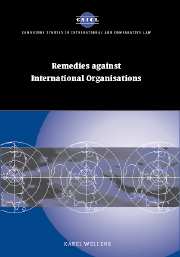Book contents
- Frontmatter
- Contents
- Acknowledgements
- List of abbreviations
- Introduction
- Part I General features of remedies against international organisations
- Part II Procedural aspects of remedial action against international organisations
- 7 Introduction to procedural aspects of remedial action against international organisations
- 8 Procedural aspects of remedial action by member states
- 9 Procedural aspects of remedial action by staff members
- 10 Procedural aspects of remedial action by private claimants
- 11 Procedural obstacles for representational non-governmental organisations
- 12 Procedural obstacles common to remedial action by non-state claimants
- Part III Substantive outcome of remedial action against international organisations
- Part IV Alternative remedial action against international organisations and options for the future
- Conclusion
- Bibliography
- Index
- CAMBRIDGE STUDIES IN INTERNATIONAL AND COMPARATIVE LAW
8 - Procedural aspects of remedial action by member states
Published online by Cambridge University Press: 13 July 2009
- Frontmatter
- Contents
- Acknowledgements
- List of abbreviations
- Introduction
- Part I General features of remedies against international organisations
- Part II Procedural aspects of remedial action against international organisations
- 7 Introduction to procedural aspects of remedial action against international organisations
- 8 Procedural aspects of remedial action by member states
- 9 Procedural aspects of remedial action by staff members
- 10 Procedural aspects of remedial action by private claimants
- 11 Procedural obstacles for representational non-governmental organisations
- 12 Procedural obstacles common to remedial action by non-state claimants
- Part III Substantive outcome of remedial action against international organisations
- Part IV Alternative remedial action against international organisations and options for the future
- Conclusion
- Bibliography
- Index
- CAMBRIDGE STUDIES IN INTERNATIONAL AND COMPARATIVE LAW
Summary
Exhaustion of internal remedies
The first forum to which member states would turn in order to challenge, even prior to its adoption, the legality of a particular decision, is the organ that is considering its adoption. That will eventually also be the first remedial level for staff members but without the same preventive effect. The importance of this possibility for member states is increased in the absence of a proper system of judicial review and in spite of the principle nemo judex in causa sua being seriously damaged. As is common in other cases such as the international financial institutions, special remedial mechanisms have been put in place.
Given the absence in most international organisations of a system of judicial review for the legality of institutional acts and operational activities, the question of the applicability of the rule of exhaustion of internal remedies does not even arise with regard to member states, except of course when it has been (explicitly) provided for in particular categories of agreements: in such cases the clause ‘other mechanisms of settlement’ could imply this first form of remedial action. The Lockerbie cases clearly demonstrate that, within the context of contentious judicial proceedings between two member states, a form of indirect remedial action could result from either of them challenging, in their application or in an incidental way, the legal validity – under, respectively, the internal law of the organisation and/or international law at large – of institutional acts or operational activities belonging to the overall legal context of the dispute between them.
- Type
- Chapter
- Information
- Remedies against International Organisations , pp. 66 - 80Publisher: Cambridge University PressPrint publication year: 2002



